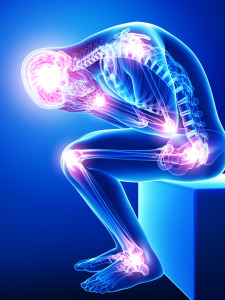Pain Management
Pain is a critical signal from our peripheral and central nervous systems that something is wrong. It is an unpleasant feeling, such as a tingle, sting, burn, or ache. Pain may be sharp or dull. It may come and go, or it may be constant. You may feel pain in one area of your body, such as your back, abdomen, legs or pelvis, or you may feel pain all over. Pain can be helpful in diagnosing a problem. If you were unable to feel pain, you might seriously hurt yourself without knowing it, or you might not realize you have a medical problem that needs treatment.
There are two types of pain: acute and chronic. Acute pain usually comes on suddenly, because of a disease, injury, or inflammation. It can often be diagnosed and treated and usually goes away. Sometimes, though, it can turn into chronic pain. Chronic pain is different. Your body keeps hurting weeks, months, or even years after the injury. Doctors often define chronic pain as any pain that lasts for 3 to 6 months or more.
Pain is not always curable, but there are many ways to treat it. Treatment depends on the cause and type of pain. You may have tried to achieve relief with pain medications, chiropractic, acupuncture, physical therapy or surgery. Hypnosis* is often helpful in achieving relief from chronic pain either separately or by working in concert with other approaches to improve their effectiveness.
A meta-analysis (a study of studies) in 2000 of 18 published studies by psychologists Guy Montgomery, PhD, Katherine DuHamel, PhD, and William Redd, PhD, showed that 75% of clinical and experimental participants with different types of pain obtained substantial pain relief from hypnotic techniques.1 Thus, hypnosis is likely to be effective for most people suffering from diverse forms of pain, with the possible exception of a minority of clients who are resistant to hypnotic interventions. Drs. Patterson and Jensen indicate that hypnotic strategies are equivalent or more effective than other treatments for both acute and chronic pain, and they are likely to save both money and time for clients and clinicians. 2 Evidence suggests that hypnosis might be considered a standard of treatment unless the person fails to respond to it or shows a strong opposition against it.
Chronic pain conditions for which hypnosis has been used successfully include, among others, headache, backache, fibromyalgia, carcinoma-related pain, temporal mandibular disorder pain, and mixed chronic pain. Hypnosis can alleviate the sensory and/or affective components of a pain experience, which may be all that is required for acute pain.
In recent years, the anecdotal evidence for the effectiveness of hypnosis to decrease sensitivity to pain has been supplemented by well-controlled experiments. In their 2003 review of controlled clinical studies, Dr. Patterson and fellow psychologist Mark Jensen, PhD, found that hypno-analgesia is associated with significant reductions in: ratings of pain, need for analgesics or sedation, nausea and vomiting, and length of stay in hospitals. Hypnosis has also been associated with better overall outcome after medical treatment and greater physiological stability. Surgeons and other health providers have reported significantly higher degrees of satisfaction among people who were treated with hypnosis than those who were not.
Depending on the phrasing of the hypnotic suggestion, the sensory and/or affective components of pain and associated brain areas may be affected as shown by the brain imaging research of neuropsychologist Pierre Rainville, PhD, and collaborators in 1999. People who are most receptive to hypnotic suggestions in general, or highly hypnotizable persons, have found the greatest and most lasting relief from hypnosis techniques, but people with moderate suggestibility (the majority of people) also show improvement. Factors such as motivation and compliance with treatment may also affect responsiveness to hypnotic suggestions.
Drs. Patterson and Jensen’s review concluded that hypnotic techniques for the relief of acute pain (an outcome of tissue damage) can be superior to standard care, and often better than other recognized treatments for pain. Furthermore, a 2002 cost analysis by radiologists Elvira Lang, MD and Max Rosen, MD, that compared intravenous conscious sedation with hypnotic sedation during radiology treatment found that the cost of the hypnotic intervention was twice as inexpensive as was the cost for the standard sedation procedure.
*We require written permission from your physician before working with you to relieve pain.
1. Montgomery, G. H., DuHamel, K. N., & Redd, W. H. (2000). A meta-analysis of hypnotically induced analgesia: how effective is hypnosis? International Journal of Clinical and Experimental Hypnosis, Vol. 48, pp. 138-153.
2. Patterson, D. R., & Jensen, M. P. (2003). Hypnosis and clinical pain. Psychological Bulletin, Vol. 129, pp. 495-521.



